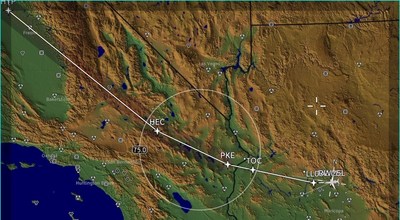PHOENIX, May 2, 2016 /PRNewswire/ -- Honeywell Aerospace
(NYSE: HON) is working with NASA's Armstrong Flight Research Center
to study the most effective way to visually inform pilots flying
supersonic jets about sonic booms, a loud noise caused by current
aircraft traveling faster than the speed of sound. Honeywell
recently flight-tested new cockpit displays that help pilots see
sonic booms before they happen so they can reroute and reduce the
effects of aircraft noise over populated areas. By predicting sonic
boom footprints, Honeywell will remove a key roadblock to speed up
the introduction of supersonic travel and support one of NASA's
goals to modernize flight.

Early in 2015, Honeywell was awarded a two-year contract as part
of NASA's Commercial Supersonic Technology (CST) Project to aid in
overcoming the issue of sonic booms as a roadblock to commercial
supersonic flight. In their first year under the contract,
Honeywell and NASA have designed and developed predictive software
and display technology that has been successfully tested in flight
over commercial airspace.
"NASA is committed to making supersonic flight over land a
reality, and key to achieving this is to reduce the impact of sonic
booms," said Bob Witwer, vice
president of Advanced Technology at Honeywell Aerospace. "Using the
Honeywell User Experience design concept, our engineering team has
tackled how to intuitively inform pilots about upcoming terrain,
weather and more — now we are helping pilots predict and visualize
noise to tackle sonic booms."
"Important to our progress in reducing the sonic boom impact
over land is to have a predictive sonic boom display in supersonic
aircraft cockpits that ensures our future quiet supersonic aircraft
remain below acceptable noise levels," said Brett Pauer, NASA CST subproject manager at
Armstrong Flight Research Center. "We have partnered with avionics
companies like Honeywell to translate our NASA algorithms into an
integrated avionics system that is tested and evaluated by
pilots."
Honeywell's predictive software and displays for supersonic jets
are in ongoing development and testing with NASA. The conceptual
designs used under NASA's Commercial Supersonic Technology Project
are tied to Honeywell's Interactive Navigation (INAV) technology.
INAV is the aerospace industry's first system providing the
simultaneous display of traffic, terrain, airspace, airways,
airports and navigation aids. INAV software is designed to allow
easy addition of new display formats to existing cockpits, and the
predictive software for sonic booms takes full advantage of this
feature, allowing it to be effortlessly incorporated into existing
and future airplanes. Already in use on Honeywell Primus Epic
integrated cockpits on Dassault, Gulfstream, Pilatus and Beechcraft
aircraft, INAV will help make the next generation of supersonic
flight a reality.
Supporting Resources
- Learn more about Primus Epic and INAV
- Read more about Honeywell Aerospace
- Follow @Honeywell_Aero on Twitter
- Subscribe to Honeywell's Corporate RSS feed
Honeywell Aerospace products and services are found on virtually
every commercial, defense and space aircraft, and its turbochargers
are used by nearly every automaker and truck manufacturer around
the world. The Aerospace business unit develops innovative
solutions for more fuel-efficient automobiles and airplanes, more
direct and on-time flights, safer flying and runway traffic, along
with aircraft engines, cockpit and cabin electronics, wireless
connectivity services, logistics, and more. The business delivers
safer, faster, and more efficient and comfortable
transportation-related experiences worldwide. For more information,
visit www.honeywell.com or follow us at @Honeywell_Aero and
@Honeywell_Turbo.
Honeywell (www.honeywell.com) is a Fortune 100 diversified
technology and manufacturing leader, serving customers worldwide
with aerospace products and services; control technologies for
buildings, homes, and industry; turbochargers; and performance
materials. For more news and information on Honeywell, please visit
www.honeywell.com/newsroom.
Honeywell and the Honeywell logo are the exclusive properties of
Honeywell, are registered with the U.S. Patent and Trademark
Office, and may be registered or pending registration in other
countries. All other Honeywell product names, technology names,
trademarks, service marks, and logos may be registered or pending
registration in the U.S. or in other countries. All other
trademarks or registered trademarks are the property of their
respective owners. Copyright 2016 Honeywell.
Photo - http://photos.prnewswire.com/prnh/20160501/362052
Logo - http://photos.prnewswire.com/prnh/20080425/LAF040LOGO
To view the original version on PR Newswire,
visit:http://www.prnewswire.com/news-releases/honeywell-and-nasa-tackle-supersonic-sound-pollution-300260408.html
SOURCE Honeywell Aerospace